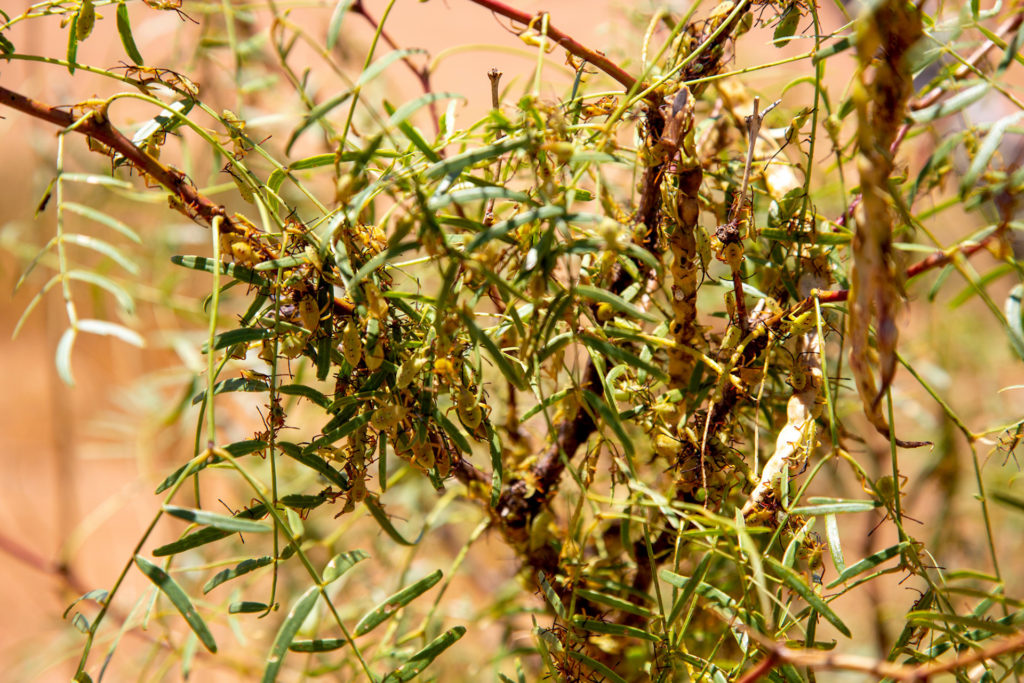Insurgence of Mozena bug concerns crop producers, homeowners alike
AgriLife Extension experts offer advice
“They are crawling all over my 10 acres. There are thousands, probably hundreds of thousands of them invading my property. They are killing my vegetation, my trees, my plants. What are they, where are they coming from, and how do I treat and control to keep what trees they have not killed alive?”

Crop producers, ranchers and homeowners are reaching out to Texas A&M AgriLife Extension Service experts across the South Plains as above-average numbers of the Mozena obtusa Uhler plant bugs are being seen.
Pat Porter, Ph.D., AgriLife Extension entomologist, Lubbock, and Kerry Siders, AgriLife Extension integrated pest management agent in Hockley, Cochran and Lamb counties, said their phones have been busy with resident reports, questions and concerns.
About the Mozena bug
Literature and research is limited on the insect, so there is still much to be learned about the bug and how much harm, and to what, it might do if the infestation is large enough.
The Mozena bug was last an issue for the South Plains in August 2014. The bug is in the family Coreidae, a group of insects given the common name of leaf-footed bugs.
“The common thread from 2014 to 2022 is our drought conditions,” said Siders.
While they can be quite annoying, they are not harmful to humans, pets or most homeowner plants unless the infestation levels are very high. The insects’ primary host is mesquite, a legume. They also feed on peas and beans.
Both Porter and Siders documented them feeding on corn and cotton in 2014.
“I noted them in cotton back in 2014, but not the sheer numbers I am seeing now, and it is a month earlier,” Siders said. “We are getting reports from the Midland and Odessa area indicating high populations there as well.”
Porter said he got the first identification requests this year on July 1 for immature Mozena in their nymph stage. He’s received requests for bug identification as far south as Odessa.
“The requests this week are still for nymphs — adults yet to come,” he said. “The small landowners, like 5-10 acres with mesquite, say they are covered up — plants, grass, houses.”
Why the concern?
Siders said he has seen as many as 20-plus nymphs per cotton plant, which is a concern.

“In a particular field I scout weekly, square set was perfect at 100% last week after the first 12 days of squaring,” he said. “Then this week it dropped to 79%. No other insects, drip cotton, good moisture, no environmental event to point a finger at, and yet squares were missing. Nothing was left to dissect to determine a possible cause of death.”
Siders said he has not found egg masses in cotton and is unsure if the nymphs hatched in the cotton field or crawled in because immatures do not have functioning wings. They can move quickly on the ground, though.
The leaf-footed bug is often treated like a stink bug; however, stink bugs typically do not feed on cotton squares but on bolls. Siders said treatment considerations might more closely resemble the Lygus when present at five-plus per plant, although they are not as damaging as a Lygus would be at these numbers.
Porter said seeing low numbers of the bugs is typical, and on a wide variety of plants, but they will only damage mesquite, peas, beans and now, apparently, cotton. They could be seen on all different kinds of crops and home plants.
Treating to prevent damage
Suhas Vyavhare, Ph.D., AgriLife Extension cotton entomologist, Lubbock, began an insecticide trial July 12 to learn more about treatment options for Mozena bugs. The objective of the trial is to gather preliminary data on the efficacy of insecticide products against them and assess pest damage potential in cotton.
“Currently, we do not know how damaging this bug is to cotton and where the treatment threshold should be,” Vyavhare said. “Our preliminary data from the research trial will be available as early as Friday. Insecticides being tested include imidacloprid, bifenthrin, cypermethrin, sulfoxaflor, dicrotophos, acephate and oxamyl.”
Siders said even for homeowners calling about this insect, he is telling them the most effective insecticides are the pyrethroid-based products. Some examples of pyrethroid active ingredients include bifenthrin, lambda-cyhalothrin, permethrin, cypermethrin and cyfluthrin. Insecticides, including organic products, work best against the nymphal stages, so frequent scouting of host plants is recommended to detect the early stages of an infestation.
As more is learned, information will be posted to https://focusonagriculture.blogspot.com/.
“And as always, when using an insecticide, read and follow label directions for safety precautions, rates and preharvest intervals,” he cautioned.



